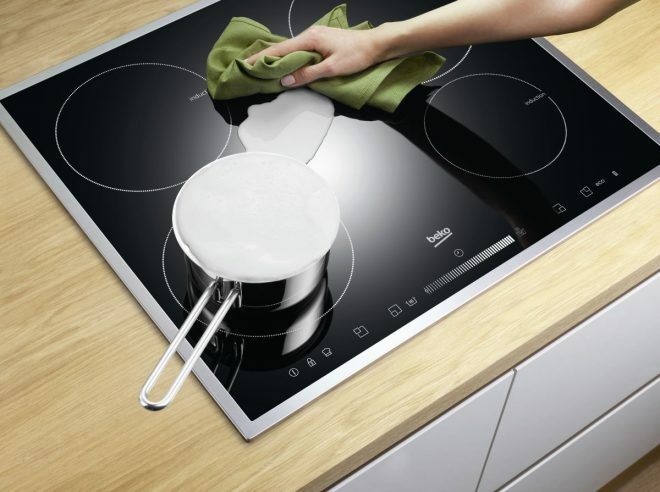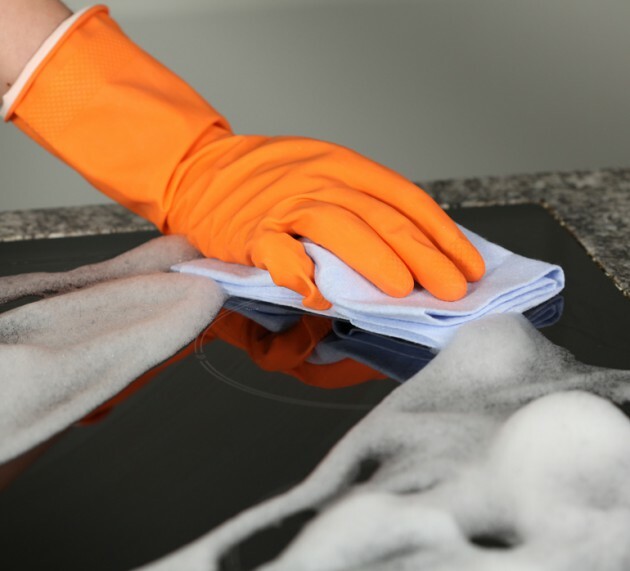Glass-ceramic hobs and hobs are becoming more and more popular due to their presentable appearance and ease of use. But how do you clean these appliances properly? They are much easier to care for than ordinary enameled ones, but they have their own nuances when cleaning.

How and how to clean at home?
How to clean a glass ceramic hob? Let's start with the correct order.
Attention! Earned on our website kitchen designer. You can familiarize yourself with it and design your dream kitchen for free! May also come in handy wardrobes designer.
- Disconnecting the device from the network.
- Next, moisten the surface with a wet cloth or sponge (but keep in mind that in some cases the stove needs to be left dry - read the cleaning methods carefully).
- Cleaning with aids.
- Abundant washing to remove chemical residues.
- Wipe dry.
Products for removing stains on glass-ceramic hobs and hobs
Of course, the easiest way is to ensure that nothing splashes onto the panel during cooking, but this is not always possible. That is why below we will consider a list of ways in which you can clean the technique. From them you can choose the most suitable one.
Folk remedies
- Olive oil. A simple and effective tool that can be used to clean the stove - you can find it in any store. The oil gently and carefully removes even the most stubborn dirt:
- dampen a soft sponge or cloth with oil;
- apply a cloth (or sponge) to the dirt and leave it there for half an hour;
- after this time, gently remove the dirt with a sponge;
- After wiping off dried dirt, wash the hob using soapy water or glass and mirror cleaners.
You can also wipe the surface with a cloth slightly moistened with oil to create a protective layer. This layer will make it easier to get rid of dirt afterwards.
- These products can be easily found in almost any kitchen, and the method itself is not difficult:
- make a mixture of soda and warm water, stir until sour cream;
- apply this substance to the stains and leave for 15 minutes - no more, since the soda should not dry out;
- in case of severe pollution, you can add lemon juice, which quickly and effectively dissolves any dried stains on glass ceramics - apply the juice directly to the soda;
- take any soft cloth or sponge and start cleaning. Wash off dirt using plenty of water to avoid soda streaks;
- if the dirt is not removed the first time, repeat the procedure. You can leave the baking soda for a slightly longer amount of time: 20-30 minutes.
Baking soda is most suitable for removing stubborn and stubborn stains without being aggressive towards the delicate glass ceramic surface. Moreover, it has a deodorizing effect and removes food odors from the panel.
- Table vinegar. It can come in handy not only when preparing marinades, but also when cleaning your hob of stubborn dirt. What do we have to do:
- first, find some kind of container with a spray bottle to spray the liquid on the dirt;
- mix vinegar and water in a container in a 50/50 ratio, shake;
- spray the solution onto the surface and leave for a short amount of time - about 10-15 minutes;
- Dry the stove well with a dry cloth or sponge.
- Ammonia is ideal as an alternative to store-bought solutions for cleaning glass and mirrors. It effectively fights off any burnt spots, adds shine to the glass-ceramic surface. The only drawback is an unpleasant smell during cleaning, so we advise you to ventilate the room during the cleaning process.
- mix water and ammonia in a container with a spray in a ratio of 250 ml to 50 ml;
- shake the container;
- spray the solution onto the surface of the stove and leave for about 10-15 minutes;
- after this time, wipe off any remaining dirt and marks well with a dry cloth or sponge.
Household chemicals
Care products for glass ceramics
Household chemical stores sell products designed specifically for cleaning glass-ceramic surfaces. They differ in that they do not have abrasive particles that can damage the coating of the plate, and have a composition that gently but effectively fights even the most stubborn dirt.
Also, these products usually contain silicone, which, when exposed to the surface, covers it with a protective a layer that makes it easier to use - the coating becomes more "flexible" when cleaning, dirt does not stick to it so much.
After cleaning according to the instructions for the product, rinse it off thoroughly with plenty of water. What for? Leftover chemicals can begin to corrode the sensitive surface of the cooker when exposed to high temperatures.
Cleaning products for glasses and mirrors
Glass and mirror cleaners are also suitable for cleaning the hob. They must be sprayed onto a cooled surface, left for a while and then wiped off with a dry cloth or sponge.
Secrets of proper cleansing
Do not use the same rags and sponges for cleaning with which you dust or wash dishes. Since after each wiping or washing the dishes, particles of old dirt may remain in the sponge, the surface of glass ceramics, washed with the same sponge, will be in ugly stains that are noticeable with the naked eye. It is advisable to purchase all the necessary cleaning utensils immediately upon purchase.
Removal of old dirt
As mentioned above, the glass-ceramic hob should be cleaned immediately after you get it dirty. But it happens that immediately there is no time or energy for cleaning, and over time, the need to wash it completely flies out of memory. During this time, the dirt can harden strongly and turn out to be almost "unkillable". In addition to the above methods to help you quickly remove impurities through their dissolution, as heavy artillery against old dirt, a scraper with metal blades. Take it and very gently scrub the dirt, then wipe the cleaned area with a sponge or cloth with detergent to keep the coating perfectly clean.
Use only metal scrapers, as plastic scrapers are not suitable for cleaning surfaces at high temperatures - they melt quickly.
Glass Ceramic Care and Prevention of Contamination
The first thing to know is that glass ceramics should be cleaned as often as possible, since even accidentally spilled water can leave dirt and streaks. What can we say about fat and oil - whether you like it or not, you will have to clean up after each cooking.
Also forget about cleaning the glass-ceramic panel with coarse brushes, metal sponges and aggressive cleaning agents, as everyone is used to cleaning the usual enamel models. Glass-ceramic is intolerant to such aggressive cleaning, as its surface is easily scratched. Oven cleaners and stain removers are not suitable.
Regular, timely and gentle cleaning is the motto for proper maintenance of the glass-ceramic hob.
Always wear rubber gloves when washing equipment with strong detergents to protect your hands from chemicals.
What not to do with glass ceramics
Despite the fact that glass ceramics is very durable and can withstand loads of any severity, it will not withstand sharp point impacts - it will immediately be covered with many small cracks.
Also, a glass-ceramic stove suffers greatly from sudden changes in temperature, for example, if you often put ice containers, pots, kettles on it. Before putting a cold kettle on a hotplate, check that it is not working, and only then turn it on.
To clean the surface, it is best to have rags specially purchased for your stove with you. Household items that have already been used will only exacerbate the pollution.
Of course, it's more pleasant when you don't have to spend a lot of time cleaning after cooking, so try to be careful. Constant dirt not only takes away your cleaning effort, but also significantly shortens the lifespan of your stove. Many defects on glass ceramics do not become noticeable to the eye immediately, for example, you will not see cracks from liquid that accidentally spilled onto neighboring burning burners. They are not immediately visible, but they appear later and lead to equipment breakdown.
Conclusion
Despite all the disadvantages described above, glass-ceramic panels are quite unpretentious and do not have difficulties in cleaning. Believe me - in practice, taking care of this technique is not difficult. It is enough only to remove dirt from the surface in a timely manner and do not forget about using careful methods. And then the stove will delight you for a long time with its luxurious appearance and excellent performance.
In addition to following the advice given by us, do not forget about the instructions for use that are given by the manufacturers of glass ceramic hobs. Not all cookers are the same - each has its own peculiarities in use.
Proper maintenance of equipment is a matter that allows you to save unnecessary funds, since glass ceramics is quite an expensive pleasure. One has only to imagine how much money it will cost to repair the device or replace it - and you immediately want to clean the stove as often as possible.
average rating 0 / 5. Number of ratings: 0
No ratings yet. Be the first to rate.



